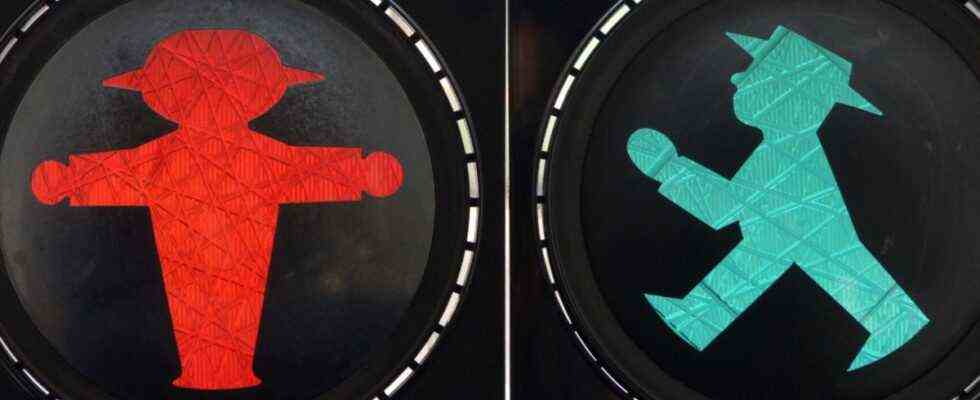While there is currently a lot of discussion in Berlin about a possible first traffic light coalition, another traffic light is celebrating its 60th birthday. On October 13, 1961, the traffic psychologist Karl Peglau submitted his draft for the new pedestrian signals: a squat man with a hat, the green one takes a big step, the red one spreads his arms. From 1969 on, it was used bit by bit in all traffic lights in East Berlin and finally in the whole of the GDR. The little east traffic light man, which today symbolizes the Ostalgie feeling, is considered to be one of the first modern pedestrian traffic lights with a pictogram of a walking and a standing person. Six interesting facts about the Ampelmännchen.
Pointing the way: In Peglau’s original design, the green man turned to the right. For ideological reasons, however – in accordance with the socialist stance – from now on it was allowed to run to the left. On souvenir items, however, it continues to run to the right, because that is the “graphically more elegant and dynamic direction”, as Ampelmann GmbH, which sells mugs, bags and T-shirts in Berlin, does on theirs Website explained. Incidentally, the company was founded by a Swabian resident of Berlin, the designer Markus Heckhausen, who at the end of the 90s also ensured that the East German man stayed on the streets of Berlin. Ampelmann’s father Peglau worked for the company until his death in 2009.
Good with a hat: As a psychologist, Peglau knew that people trust above all those whom they find sympathetic and know. So he gave the male a plump, small figure and a nice knobbly nose. At first he wasn’t sure whether he should put a hat on his pedestrian, as it stood for evil capitalism in the GDR. But after Peglau saw Erich Honecker with a straw hat on television, his ideological concerns were allayed. Incidentally, the shape of the hat comes from the hand of Peglau’s secretary Anneliese Wegner, whose talent for drawing he valued.
Comprehensive: The hat and the squat figure had another use: They are more flat than those of the later thin traffic light men from the west and therefore more visible. A team of researchers from Jacobs University Bremen found out in 2013 that the eastern males “actually have an advantage over the western traffic light males when it comes to signal perception,” according to Claudia Peschke, one of the authors of the study, summarized.
Old East: Many a Berlin tourist falls into the mistake of being able to tell from the Ostmännchen which districts once belonged to East Berlin. However, the Peglau males can now also be found in the former West Berlin, as well as in other (West) German cities. In addition to the East Male and some West Male, who at least still have feet and necks, the Euro male is the most common in Germany today. It consists of bars and a point – nothing with cuteness.
Traffic light female: When it comes to the design of the traffic light man, the following is only stipulated according to the road traffic regulations: “If the light signals only apply to people walking (…), this is indicated by the symbol” pedestrian “(…).” How exactly this should look like remains open – and leaves room for “traffic light women” such as in Cologne and Zwickau or same-sex couples such as in Frankfurt and Munich. Other cities use local celebrities as traffic light men for city marketing: Beethoven in Bonn, Marx in Trier, Luther in Worms. Fictional characters are also suitable for this, such as the town musicians in Bremen, the Mainzel males in Mainz, puppets from the puppet box in Augsburg.
Human males: The standard traffic light men in Prague were too tight for the Czech artist Roman Týc and in 2007 he exchanged them for peeing, drinking and staggering men during a guerrilla campaign. For this he received a prize at a film festival in Vienna, but also received a fine of 2500 euros. Because he didn’t want to pay it, Týc had to go to prison for a month. A great price for liberated traffic light men.

